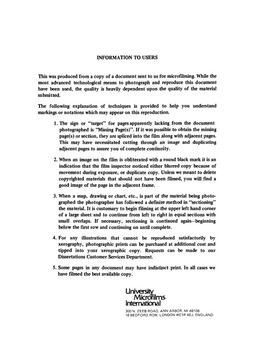| dc.contributor.author | Cleary, Michael Terence, | en_US |
| dc.date.accessioned | 2013-08-16T12:27:58Z | |
| dc.date.available | 2013-08-16T12:27:58Z | |
| dc.date.issued | 1980 | en_US |
| dc.identifier.uri | https://hdl.handle.net/11244/4699 | |
| dc.description.abstract | The electrochemical oxidation of xanthosine was shown to be nearly identical to that of 9-methylxanthine. The major difference being the ribose substituent in the observed products. | en_US |
| dc.description.abstract | The second oxidation peak of 9-methylxanthine is due to further electrochemical oxidation of 8,8'-Bi-9-methyl-9H-purine-2,6-(1H, 3H)-dione in a 2e('(CRMINUS)) (pH 7) or a 2e('(CRMINUS)), 2H('(CRPLUS)) (pH 4) to give 8,8'-Bi-9-methyl-9H-purine-2,6-(1H)-dione -3,5-(3H)-diiminylidene. | en_US |
| dc.description.abstract | In the course of these electrochemical studies, a liquid chromatographic method utilizing a dual column system (Sephadex G-10 gel permeation and QAE-Sephadex A-25 anion exchange) was developed for the quantitative separation of mixtures of compounds found as products of electrochemical oxidation of biologically important purines. Milligram quantities of such product mixtures may be separated and often the height or area of the chromatographic peaks may be used for quantitative analysis. | en_US |
| dc.description.abstract | 9-methylxanthine is initially electrochemically oxidized (1e('(CRMINUS)), 1H('(CRPLUS)) at pH 4 or 1e('(CRMINUS)) at pH 7) at its first oxidation peak to give a radical. This radical can either dimerize to give 8,8'-Bi-9-methyl-9H-purine-2,6-(1H, 3H)-dione or be further oxidized to 9-methyluric acid. Any 9-methyluric acid formed oxidizes, hydrates, and fragments in essentially the same way as described for the third and fourth oxidation peaks, the same products being observed. | en_US |
| dc.description.abstract | The qualitative course of electrochemical oxidation of 9-methylxanthine and xanthosine at the pyrolytic graphite electrode (PGE) has been examined between pH 2-9, the most commonly encountered pH range in biological systems. Xanthosine represents the first investigation from our laboratory concerning the electrooxidation pathways and products of a purine nucleoside. | en_US |
| dc.description.abstract | Over the pH range 2-9, 9-methylxanthine shows up to four well defined oxidation peaks at the PGE. At its third and fourth oxidation peaks, 9-methylxanthine undergoes an initial 2e('(CRMINUS)), 2H('(CRPLUS)) oxidation of the N(, 7) = C(, 8) bond to give 9-methyluric acid which, being more easily oxidized that 9-methylxanthine, is immediately further oxidized (2e('(CRMINUS)), 2H('(CRPLUS)) at pH 4 or 2e('(CRMINUS)), 1H('(CRPLUS)) at pH 7) to 9-methyluric acid diimine. Complete hydration of the diimine gives rise to 9-methyluric acid-4,5-diol that breaks down to 1-methylallantoin, alloxan, methylurea, methylparabanic acid, urea, and 1-methyl-2-oxy-4,5 dihydroxy-imidazole at pH 4 and 1-methylallantoin at pH 7. | en_US |
| dc.format.extent | xiii, 332 leaves : | en_US |
| dc.subject | Chemistry, Analytical. | en_US |
| dc.title | The effect of substitution at the 9 position of the electrochemical oxidation of xanthine. | en_US |
| dc.type | Thesis | en_US |
| dc.thesis.degree | Ph.D. | en_US |
| dc.thesis.degreeDiscipline | Department of Chemistry and Biochemistry | en_US |
| dc.note | Source: Dissertation Abstracts International, Volume: 41-02, Section: B, page: 0557. | en_US |
| ou.identifier | (UMI)AAI8016925 | en_US |
| ou.group | College of Arts and Sciences::Department of Chemistry and Biochemistry | |
